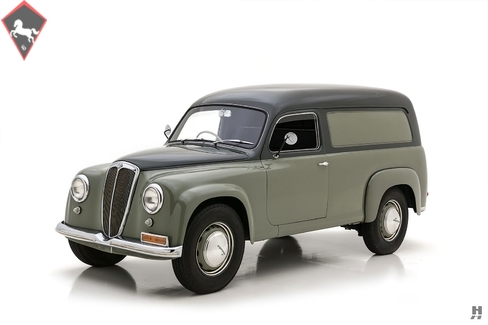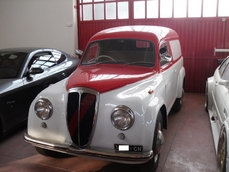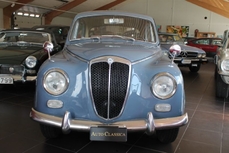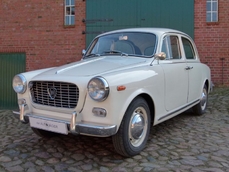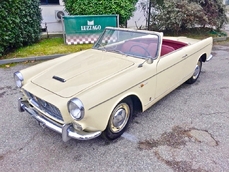Lancia Appia Van 1956
Allgemeine Beschreibung :
Lancia introduced the all-new Appia at the 1953 Turin Salon. The long-awaited replacement for the outgoing Ardea, the Appia served as Lancia’s entry-level model below the fabulous Aurelia. The entirely-new Appia shared only the old Ardea’s layout of a front-mounted V4 driving the rear wheels via a live axle, but the engine, gearbox, and platform were designed from the ground up. It was a busy time for Lancia, with the factory also working on a replacement for the Aprilia, and revamping the racing cars. The legendary engineer Vittorio Jano seemed to be burning the candle at both ends, developing new race engines while still finding time to dedicate to production cars. For the Appia, he created a brilliant new narrow-angle V4 engine. The new V4 shared little with the outgoing overhead cam unit, reverting to pushrod valve actuation, with twin camshafts mounted low in the cylinder block, topped with a single aluminum cylinder head. The narrow 14-degree V-angle kept the engine extremely compact, although it was somewhat tall. At 1,090 cc, it was the same dimensions as a contemporary Fiat 1100 and made a modest 38 horsepower at 4400 rpm in standard form, giving the lightweight Appia platform lively performance. Power went to the rear wheels via a 4-speed manual gearbox with synchro on the top three forward gears, shifted via a column-mounted lever as was de rigueur for Lancia in the 1950s.
Similar to its larger siblings, the Appia chassis featured patented sliding pillar front suspension, live axle on leaf springs, and an incredibly sturdy monocoque platform. The robust structure not only gave the Appia unrivaled rigidity and quality, but it allowed for a wide variety of body styles to be easily adapted, and the factory offered the option of a bare chassis for coachbuilders. The Appia proved to be wildly successful, with saloon sales topping 100,000 cars over ten years.
In addition to the standard four-door saloon, and coachbuilt models, buyers could select a light commercial version of the Appia designated the C80, C83 or C86. These models featured a slightly detuned version of the 1,090 cc V4 (for durability), larger 16-inch wheels and tires to carry a higher payload, and could be specified as a pickup (Camioncino), small delivery van (Furgoncino), or ambulance (Autolettiga). A short rear axle ratio and 5-speed gearbox compensated for the detuned engine and made the Appia surprisingly capable even when carrying a load. The commercial Appia is considerably rarer than its saloon counterpart, with production touching just 8,000 units between 1954 and 1959.
Featured here is a lovely example of Lancia’s endearing Appia Furgoncino. Hailing from 1956, this is a Series II C 80 model and is believed to be one of approximately 2,900 of its kind produced. It is in home market specification with right-hand drive, as Italy was one of the last holdouts of left-hand traffic on mainland Europe after the war. While the commercial Appia was relatively popular in its day, as with any commercial vehicle, attrition rates are high as these little trucks were subjected to daily abuse. Thankfully, this wonderful Furgoncino (literally, “small van”) lived a gentle enough life to earn a well-deserved restoration back to original specs. According to a previous owner, the ground-up restoration was done in Switzerland and has seen only light use since. The paintwork presents in good condition, showing a few minor imperfections in the finish but otherwise well-detailed. Typical for Lancias of the era, the body is beautifully crafted with doors that open and shut with Mercedes-like solidity, and a sensation of quality that belies its purpose as an economical delivery car. Chrome adornments are minimal but present in good condition overall. Some polish marks are evident in the bumper, while the Carello headlight rims and proud Lancia radiator grille are excellent. Polished aluminum hubcaps adorn the correct 16-inch wheels with period-correct Michelin X radials (Lancia was an early adopter and champion of the radial tire). At the back, twin barn-doors open up to a generous cargo area with a spare wheel neatly slotted below the load floor.
The driver’s compartment is neat, tidy and suitably minimalist, with hard-wearing vinyl upholstery on the bench seat and door panels, and durable rubber floor mats. Switches, controls, and the instrument cluster appear to be in superb original condition. The original ivory steering wheel has a few cracks, yet it conforms nicely to the charming and honest presentation of the cabin.
Lancia’s brilliant, energetic little V4 engine sits beneath the bonnet, fed by a single Weber carburetor on a side-mounted manifold. This example retains the original, commercial-spec 5-speed manual gearbox, and it sounds absolutely marvelous on the go. The presentation is tidy and authentic, with a mix of lightly restored and original components and fittings. Even for their utility vehicles, Lancia did not cut out the lovely details, evident by touches like the Lancia logo cast into the exhaust manifold and the lubrication chart printed on the underside of the bonnet.
This rare and delightful Appia Furgonchino is a wonderful example of Lancia’s ingenuity, unmistakable style, and exquisite craftsmanship. It would make an eye-catching promotional piece for a business, or a fabulous and unique pit car for vintage racing and period revival meetings like Goodwood. However the next caretaker chooses to enjoy it, this Appia will be a worthy addition to any collection of Lancia automobiles.
Offers welcome and trades considered
https://hymanltd.com/vehicles/6528
1956 Lancia Appia Van is listed verkauft on ClassicDigest in St. Louis by Mark Hyman for $63500.
Fakten der Auto
Karosserietyp : Auto Marke : Lancia Modell : Appia Ausführung : Van Hubraum : 0.0 Modelljahr : 1956 Karosstyp : Lieferwagen Lage : Missouri
Verkauft
Angaben Zum Verkäufer
Verkauft
People who viewed this Lancia Appia also viewed similar Lancia listed at ClassicDigest
Other cars listed for sale by this dealer
über Lancia
Ah, Lancia, die italienische Marke, die auf dem schmalen Grat automobiler Brillanz getanzt hat! Lass mich dich auf eine Reise durch die fesselnde Geschichte von Lancia mitnehmen, einer Marke, die Leidenschaft, Innovation und Rallye-Erfolg verkörpert.Akt 1: Die Frühen Jahre (1906-1920er)
Lancia wurde 1906 von Vincenzo Lancia gegründet, einem Ingenieursgenie mit einer Vorliebe für das Außergewöhnliche. Die Marke erlangte schnell einen Ruf für ihre präzise Ingenieurskunst und innovative Herangehensweise. Der Lancia Alpha, 1907 eingeführt, war das erste Auto mit einem schmalen V4-Motor und setzte den Ton für Lancias Einsatz für technische Exzellenz.
Akt 2: Innovation im Zentrum (1930er-1950er)
Die 1930er Jahre sahen Lancia die Grenzen der Innovation mit Modellen wie dem Lambda ausloten, dem ersten Auto mit selbsttragender Monocoque-Chassis. Der in den 1930er Jahren eingeführte Aprilia präsentierte wegweisende Aerodynamik und einen V4-Motor und festigte Lancias Ruf als Pionier.
Akt 3: Eleganz der Nachkriegszeit (1950er-1960er)
Nach dem Zweiten Weltkrieg begeisterte Lancia weiterhin mit Modellen wie dem Aurelia, dem ersten Serienauto mit einem V6-Motor. Es verband Leistung mit Komfort und Eleganz. Der Flaminia folgte und verkörperte Luxus und fortschrittliche Technik.
Akt 4: Rallye-Dominanz (1970er-1980er)
Lancia hat sich mit einer beispiellosen Rallye-Geschichte einen Platz in der Motorsportgeschichte gesichert. Der Lancia Stratos, ein keilförmiges Wunder, dominierte die Rallyeszene in den 1970er Jahren und holte von 1974 bis 1976 drei aufeinanderfolgende Rallye-Weltmeisterschaften. Der Delta Integrale, in den 1980er Jahren eingeführt, setzte diese Rallye-Herrschaft mit mehreren Meisterschaften fort.
Akt 5: Herausforderungen und Widerstandsfähigkeit (1990er-2000er)
Das späte 20. Jahrhundert brachte finanzielle Herausforderungen für Lancia mit sich, was zu Zusammenarbeiten mit anderen Automobilherstellern führte. Trotz der Schwierigkeiten führte Lancia Modelle wie den Thesis und den Ypsilon ein, die den Einsatz für Stil und Substanz zeigten.
Akt 6: Neuerfindung im 21. Jahrhundert (2010er-Heute)
In den 2010er Jahren konzentrierte sich Lancia auf die Ypsilon als Hauptmodell, um die Markenstrategie neu auszurichten. Obwohl die Produktionszahlen zurückgingen, behielt die Marke ihren Ruf für unverwechselbares Design und Komfort bei.
Epilog: Ein Erbe von Leidenschaft und Innovation
Lancias Geschichte ist eine von Leidenschaft, Innovation und Motorsporterfolg. Die Marke, mit ihren bahnbrechenden Designs, technologischen Fortschritten und Rallyetriumphen, hat einen unauslöschlichen Eindruck in der Automobilwelt hinterlassen. Lancia mag in den letzten Jahren Herausforderungen gegenüberstehen, aber ihr Erbe lebt weiter, gefeiert von Enthusiasten, die die Magie in jedem Lancia-Werk erkennen
